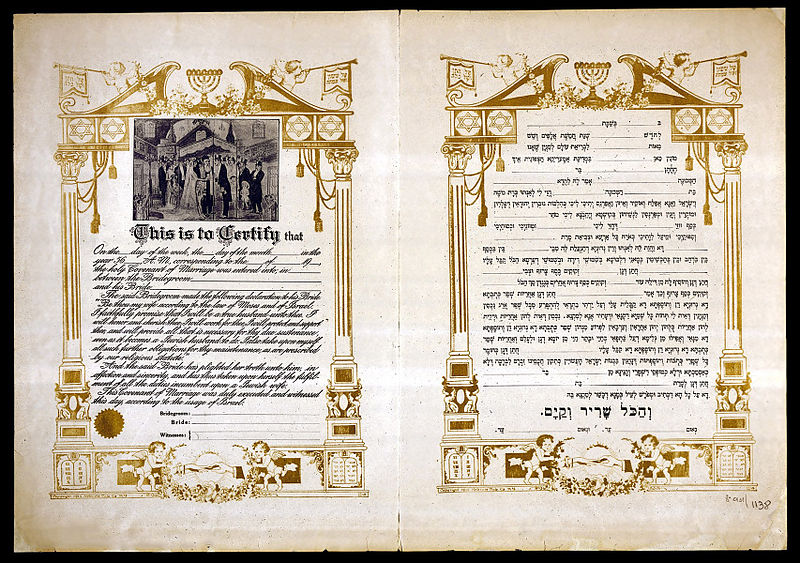The ketubah is essentially a legal document whose text can be a bit arcane (something we looked at last time). But for most couples it is an enduring and unique piece of art, and a remembrance of their special day under the chuppah.
If you are looking for inspiration for your own ketubah or just love Judaic art, the site to visit is the Ketubot Digitization Project. It includes over 4,200 Jewish marriage documents from all over the world, including Israel‘s National Library’s collection. You can browse through ketubot from around the world including classical ones from Afghanistan, Morocco, Latin America and Myanmar.
And closer to home, there are links to digitized ketubot from the Reuben & Helene Dennis Museum at Toronto’s Beth Tzedec Congregation and the Jacob M. Lowy Collection at Library and Archives Canada in Ottawa.
The oldest ketubah on this site dates back to the year 1023 in Eretz Yisrael between the groom, Natan HaCohen HaTzefati ben Shlomo and his bride, Rachel. Almost one millennium later, you can see Natan and Rachel’s ketubah online – and dream about their lives together. For more about this incredible collection, see the article in Cultivate Interactive magazine.
If you are considering having a ketubah done professionally, ketubah.com showcases the work of over fifty exceptional artists. Founded by Canadian Michael Shapiro in 1996, it describes itself as “the number one ketubah provider in the world.” Prices on the site range from US $100 to $1000 and up.
According to The Beauty of the Ketubah, splurging on a ketubah is not a new phenomenon: “So great was the desire for a splendidly illuminated ketubah in the Ancona Jewish community [of Italy] in the latter part of the eighteenth century, that Jewish communal authorities found it necessary to forbid spending more than forty paoli for ketubah ornamentation.”
If you want to own a truly unique ketubah – and possess some artistic flair – then why not create one yourself? I came across a site where the bride’s mother decided to paint one as a wedding gift. She provides step-by-step instructions, along with these words to the faint of heart:
“Don’t be afraid to try! If you mess it up, you can always start again (or buy one). And as my daughter pointed out, in this day and age it’s not that much of a trick to have something that’s perfect – computers do it every day. What’s exceptional is to have something made by hand, something personal, something with the quirks, eccentricities, and yes, even mistakes that show it’s made by a human being.”
If you want to see more designs, here are two great places where you will find thousands of ketubot, mostly contemporary. Both Google Images and Flickr will not disappoint.
You’ve got the inspiration. You’ve got the design. Now you need the text. The Rabbinical Council of America provides a variety of traditional versions along with contemporary wording at ruthbeker.com. Since a ketubah is a religious document, it is advisable to check with a trusted rabbi before embarking on your project.
Your ketubah is now complete (Mazel tov!) and you want to keep it perfect. Here’s a practical piece of advice if you’re planning an out-of-town wedding and will be travelling with your ketubah. Roll it between sheets of acid-free tissue paper and pack it in an extra strong tube. “When you get to the location of your wedding, take your ketubah out of the tube, and let it unroll. The paper will keep its curl for a while, but don’t worry. The paper of your ketubah should easily ‘forget’ the curl over time.”
After the wedding is over and you have hung your ketubah on your wall, Anita Diamant says don’t just admire your ketubah, read it regularly. Diamant quotes the Baal Shem Tov, the 18th century founder of Hasidism who “advised couples to re-read their ketubah whenever they were fighting. It would remind them, he said, of how they felt as brides and grooms – hopeful, smitten, surrounded by good wishes.”
But Diamant says it shouldn’t take a fight to get couples to re-read their ketubah. “It ought to be one of those health-and-safety habits, like checking your smoke detector when you change the clocks for daylight savings. Likewise, on every wedding anniversary, Jewish couples should sit down and read the contract they signed with stars in their eyes… Even the most exquisite ketubah is never simply a work of art. A ketubah always signifies the Jewishness of a love story, a marriage, a home, a family, a past and a future.”
